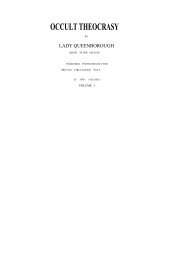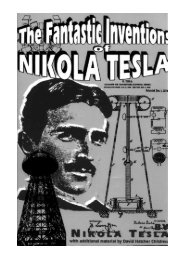the fantastic inventions of nikola tesla - Exopolitics Hong Kong
the fantastic inventions of nikola tesla - Exopolitics Hong Kong
the fantastic inventions of nikola tesla - Exopolitics Hong Kong
Create successful ePaper yourself
Turn your PDF publications into a flip-book with our unique Google optimized e-Paper software.
doubt that to such small disturbance as might be caused in an experiment <strong>the</strong> earth behaves as an almost perfect<br />
condenser. But it might be different when its charge is set in vibration by some sudden disturbance occurring in <strong>the</strong><br />
heavens. In such case, as before stated, probably only little <strong>of</strong> <strong>the</strong> energy <strong>of</strong> <strong>the</strong> vibrations set up would be lost into<br />
space in <strong>the</strong> form <strong>of</strong> long e<strong>the</strong>r radiations, but most <strong>of</strong> <strong>the</strong> energy, I think, would spend itself in molecular impacts<br />
and collisions, and pass <strong>of</strong>f into space in <strong>the</strong> form <strong>of</strong> short heat, and possibly light, waves. As both <strong>the</strong> frequency <strong>of</strong><br />
<strong>the</strong> vibrations <strong>of</strong> <strong>the</strong> charge and <strong>the</strong> potential are in all probability excessive, <strong>the</strong> energy converted into heat may be<br />
considerable. Since <strong>the</strong> density must be unevenly distributed, ei<strong>the</strong>r in consequence <strong>of</strong> <strong>the</strong> irregularity <strong>of</strong> <strong>the</strong> earth's<br />
surface, or on account <strong>of</strong> <strong>the</strong> condition <strong>of</strong> <strong>the</strong> atmosphere in various places, <strong>the</strong> effect produced would accordingly<br />
vary from place to place. Considerable variations in <strong>the</strong> temperature and pressure <strong>of</strong> <strong>the</strong> atmosphere may in this<br />
manner be caused at any point <strong>of</strong> <strong>the</strong> surface <strong>of</strong> <strong>the</strong> earth. The variations may be gradual or very sudden, according<br />
to <strong>the</strong> nature <strong>of</strong> <strong>the</strong> general disturbance, and may produce rain and storms, or locally modify <strong>the</strong> wea<strong>the</strong>r in any<br />
way. From <strong>the</strong> remarks before made one may see what an important factor <strong>of</strong> loss <strong>the</strong> air in <strong>the</strong> neighborhood <strong>of</strong> a<br />
charged surface becomes when <strong>the</strong> electric density is great and <strong>the</strong> frequency <strong>of</strong> <strong>the</strong> impulses excessive. But <strong>the</strong><br />
action as explained implies that <strong>the</strong> air is insulating—that is that it is composed <strong>of</strong> independent carriers immersed in<br />
an insulating medium. This is <strong>the</strong> case only when <strong>the</strong> air is at something like ordinary or greater, or at extremely<br />
small, pressure. When <strong>the</strong> air is slightly rarefied and con ducting, <strong>the</strong>n true conduction losses occur also. In such<br />
case, <strong>of</strong> course, considerable energy may be dissipated into space even with a steady potential, or with impulses <strong>of</strong><br />
low frequency, if <strong>the</strong> density is very great.<br />
When <strong>the</strong> gas is at very low pressure, an electrode is heated more because higher speeds can be reached. If <strong>the</strong> gas<br />
around <strong>the</strong> electrode is strongly compressed, <strong>the</strong> displacements, and consequently <strong>the</strong> speeds, are very small, and<br />
<strong>the</strong> heating is insignificant. But if in such case <strong>the</strong> frequency could be sufficiently increased, <strong>the</strong> electrode would be<br />
brought to a high temperature as well as if <strong>the</strong> gas were at very low pressure; in fact, exhausting <strong>the</strong> bulb is only<br />
necessary because we cannot produce (and possibly not convey) currents <strong>of</strong> <strong>the</strong> required frequency.<br />
Returning to <strong>the</strong> subject <strong>of</strong> electrode lamps, it is obviously <strong>of</strong> advantage in such a lamp to confine as much as<br />
possible <strong>the</strong> heat to <strong>the</strong> electrode by preventing <strong>the</strong> circulation <strong>of</strong> <strong>the</strong> gas in <strong>the</strong> bulb. If a very small bulb be taken,<br />
it would confine <strong>the</strong> heat better than a large one, but it might not be <strong>of</strong> sufficient capacity to be operated from <strong>the</strong><br />
coil, or, if so, <strong>the</strong> glass might get too hot. A simple way to improve in this direction is to employ a globe <strong>of</strong> <strong>the</strong><br />
required size, but to place a small bulb, <strong>the</strong> diameter <strong>of</strong> which is properly estimated, over <strong>the</strong> refractory button<br />
contained in <strong>the</strong> globe. This arrangement is illustrated in Fig. 28. The globe L has in this case a large neck n,<br />
allowing <strong>the</strong> small bulb b to slip through. O<strong>the</strong>rwise <strong>the</strong> construction is <strong>the</strong> same as shown in Fig. 18, for example.<br />
The small bulb is conveniently supported upon <strong>the</strong> stem s, carrying <strong>the</strong> refractory button m. It is separated from <strong>the</strong><br />
aluminium tube a by several layers <strong>of</strong> mica M, in order to prevent <strong>the</strong> cracking <strong>of</strong> <strong>the</strong> neck by <strong>the</strong> rapid heating c f<br />
<strong>the</strong> aluminium tube upon a sudden turning on <strong>of</strong> <strong>the</strong> current. The inside bulb should be as small as possible when it<br />
is desired to obtain light only by incandescence <strong>of</strong> <strong>the</strong> electrode. If it is desired to produce phosphorescence, <strong>the</strong><br />
bulb should be larger, else it would be apt to get too hot, and <strong>the</strong> phosphorescence would cease. In this arrangement<br />
usually only <strong>the</strong> small bulb shows phosphorescence, as <strong>the</strong>re is practically no bombardment against <strong>the</strong> outer globe.<br />
In some <strong>of</strong> <strong>the</strong>se bulbs constructed as illustrated in Fig. 28 <strong>the</strong> small tube was coated with phosphorescent paint,<br />
and beautiful effects were obtained. Instead <strong>of</strong> making <strong>the</strong> inside bulb large, in order to avoid undue heating, it<br />
answers <strong>the</strong> purpose to make <strong>the</strong> electrode m larger. In this case <strong>the</strong> bombardment is weakened by reason <strong>of</strong> <strong>the</strong><br />
smaller electric density.<br />
Many bulbs were constructed on <strong>the</strong> plan illustrated in Fig. 29. Here a small bulb b, containing <strong>the</strong> refractory button<br />
m, upon being exhausted to a very high degree was sealed in a large globe L, which was <strong>the</strong>n moderately exhausted<br />
and sealed <strong>of</strong>f. The principal advantage <strong>of</strong> this construction was that it allowed <strong>of</strong> reaching extremely high vacuum,<br />
and, at <strong>the</strong> same time use a large bulb. It was found, m <strong>the</strong> course <strong>of</strong> experiences with bulbs such as illustrated in<br />
Fig. 29, that it was well to make <strong>the</strong> stem s near <strong>the</strong> seal at e very thick, and <strong>the</strong> leading-in wire w thin, as it occurred<br />
sometimes that <strong>the</strong> stem at e was heated and <strong>the</strong> bulb was cracked. Often <strong>the</strong> outer globe L was exhausted<br />
only just enough to allow <strong>the</strong> discharge to pass through and <strong>the</strong> space between <strong>the</strong> bulbs appeared crimson,<br />
producing a curious effect. In some cases, when <strong>the</strong> exhaustion in globe L was very low, and <strong>the</strong> air good<br />
conducting it was found necessary, in order to bring <strong>the</strong> button m to high incandescence, to place, preferably on <strong>the</strong><br />
upper part <strong>of</strong> <strong>the</strong> neck <strong>of</strong> <strong>the</strong> globe, a tinfoil coating which was connected to an insulated body, to <strong>the</strong> ground, or to<br />
<strong>the</strong> o<strong>the</strong>r terminal <strong>of</strong> <strong>the</strong> coil, as <strong>the</strong> highly conducting air weakened <strong>the</strong> effect somewhat, probably by being acted<br />
upon inductively from <strong>the</strong> wire w, where it entered <strong>the</strong> bulb at e. Ano<strong>the</strong>r difficulty—which, however, is always<br />
present when <strong>the</strong> refractory button is mounted in a very small bulb existed in <strong>the</strong> construction illustrated in Fig. 29,<br />
namely, <strong>the</strong> vacuum in <strong>the</strong> bulb b would be impaired in a comparatively short time.









